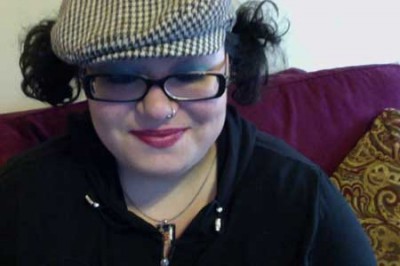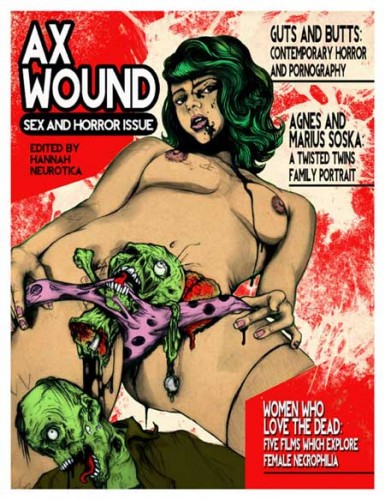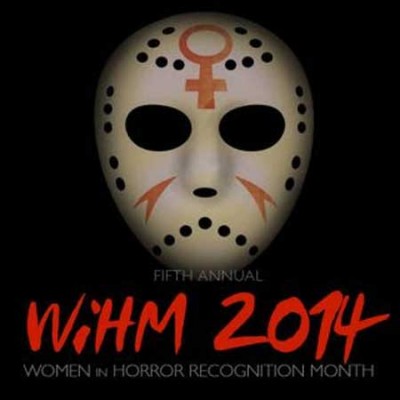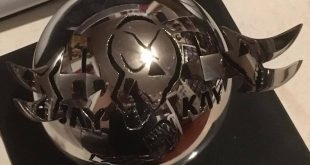 Hannah Neurotica is the creator of the feminist horror zine Ax Wound, as well as a key figure/leader in the Women in Horror Month celebration. She was kind enough to take some time and share some of her insight and experiences with us.
Hannah Neurotica is the creator of the feminist horror zine Ax Wound, as well as a key figure/leader in the Women in Horror Month celebration. She was kind enough to take some time and share some of her insight and experiences with us.
HorrorNews: So, who is Hannah Neurotica?
Hannah Neurotica: I am a neurotic, bipolar, fat Jewish grrrl artist & writer who loves horror and long walks on the beach. . . .
HorrorNews: How did you get into the horror world? Was there a specific movie or book, or a general era that drew you in?
Hannah: When I was very young (early 80s) we got our first VCR my dad would rent horror movies to show me. He is completely responsible for my life-long horror obsession. Sadly, he passed away in January 2010, right before the first Women in Horror Month, but up until then he was (and always will be) my favorite person to watch and talk films with, especially horror.
The first movie he rented that I remember being super scared of was Ghostbusters. I know that sounds silly. That may not qualify as a horror movie but if y’all have read interviews with me in the past you know that f*cking purple library ghost really f*cked with my head. I also developed a fear of vampires after watching Salem’s Lot with him. There is a comfort as a child when you know that vampires can only bother you if you let them in. But there didn’t seem to be any rules about keeping purple librarian ghosts out of your closet.
HorrorNews: What are some of your favorite horror movies, both the ones that got you into the genre as well as the ones that keep you involved?
Hannah: In interviews, I have said my favorite horror film is the original Texas Chainsaw Massacre. I f*cking love that film and it is absolutely a favorite. The truth is, when I call anything a “favorite,” I get this dishonest feeling because I love so many films/art/music on equal ground — they appeal to me in different moods, situations, etc. No artist can ever produce what another artist can, so I love to see the individualism and take each film I enjoy on its own merits. I am probably one of the least competitive people you will ever meet. This is why I no longer review films or call myself a film critic. I am far more interested in exploring timeless themes and individual filmmakers’ creative process/intentions and diverse interpretations of cinematic fear. I won’t spend time writing about a film I hate. It takes away from the energy I could use to showcase something awesome.
My horror watching habits are very binge-y. I get in the mood for a specific sub genre (monster movies, sea creature, disaster, eco-horror, abandoned mental hospital backdrops, etc) and then I watch every possible movie I can in that specific sub genre for a couple months until I have my fill and move on to the next. And since there are always new films, and the classics never get old, my cycle always circles back around.
HorrorNews: You are the force behind Ax Wound, a feminist horror zine that boasts a list of fans ranging from Jen & Sylvia Soska to Eli Roth and Herschell Gordon Lewis. How did that come about? Is Ax Wound open to submissions?
Hannah: Ax Wound started because I wanted to explore the concepts presented by Carol Clover in the classic book, Men, Women, and Chainsaws. Nobody I was hanging out with at the time was really into these conversations – except my dad. He always had the most brilliant insights. I had friends who liked horror movies, but no one that wanted to explore them beyond “Was it scary? Did you like it?” etc. I was lonely and desperate to find other feminist horror fans that wanted to explore the genre in new ways outside of academia. I felt the urge to carve out a place that didn’t exist in the heavily guarded fanboy community that was horror (something that has shifted dramatically in the last decade). Many people would think a glue stick, paper, sharpies, and copy machine couldn’t possibly have an impact on the larger horror culture (or any subculture for that matter).
I like to think I have proven that one person can make a difference if they don’t give up, have no ego about anything, and passionately need to see things change for the better. When I created Ax Wound, it was early 2006; you couldn’t go online and easily find other people (especially ladies!) to have these sorts of conversations with. In fact, when I did reach out on general horror message boards for girls like me, it was a disaster. Fanboys attacked my posts like flies on sh*t. There were no websites/magazines/media that had any sort of space for fangirls, let alone intelligent discourse. My little zine was picked up by DIY zine distros and via the mail & I slowly began to meet like-minded men and women who were equally excited to be having these conversations. Also, thanks to Heidi Honeycutt, I was able to meet many of the people I now consider my horror family. She had begun Pretty/Scary around the same time as Ax Wound. Not only did she get in touch, she offered Ax Wound its own message board on her website.
The zine got mainstream attention after Newsweek contacted me for an interview. I honestly was so shocked and excited I almost passed out. It was the first time anyone outside of a message board found my zine and the first time anyone wanted to interview me for any sort of media. Thanks to Eli Roth, I met Jen and Sylvia Soska years later and, interesting trivia, Ax Wound was their first full print interview. (We met on Myspace. That should date this pretty well.) Ax Wound has been on hold but is making a comeback in October, 2014. If anyone is interested in being involved, definitely get in touch. (http://www.axwoundzine.com/)
HorrorNews: A lot of people would believe that putting the words “feminist” and “horror” together would create an oxymoron. How would you answer their criticisms?
Hannah: I find a lot of those criticisms come from people who are not horror fans or who don’t have any respect for the genre beyond surface level, rainy day entertainment. If you love horror, it should bring you joy that there is so much density to study, perspectives to explore (gender, sexuality, race, the films themselves, the industry, etc). You don’t have to agree with every theorists’ view (obviously!), but you can’t knock the existence of the theorists. There are huge bodies of work on this subject. Books rule. So does critical thinking. Those two make a great combination.
HorrorNews: You also play a role in the Women in Horror Month (February). Tell us about that. How long has that been going on? How did it come about?
Hannah: I started Women in Horror Month via a call to action published on my blog sometime in September 2009. So this year (February 2014) marked the fifth year. How insane is that?
In 2009, I was invited to be on a CBC radio segment about this subject (women and horror fandom) alongside Jovanka Vuckovic (filmmaker, writer) and Aviva Briefel (writer/film studies professor). The producer of the show spoke with me on the phone before the live show and expressed her shock that there truly was a female fan base. Long story short, I was inspired by my frustration and anger, so I turned it into something positive.
HorrorNews: Why is it important to have a Women in Horror Month?
Hannah: Women in Horror Month provides an outlet for us to show films/art and create spaces that didn’t exist previously. We can’t sit around waiting for people to open doors for us – we will end up with smacks in our face every time.
As a woman – as any member of a marginalized group- you are never going to be handed anything. Sometimes you just gotta take a chainsaw to a brick wall and carve out a space that didn’t exist before. People will talk sh*t- you will get dirt all over you at some point in the process- but in the end you change things, even if just for a small group. That positivity reverberates across your communities and beyond. Being proactive toward change (something you feel strongly about) is important regardless of if it is part of Women in Horror Month.
Women in Horror Month, or any “month,” “week,” or “day” of recognition/celebration of the like, are not in place to limit anyone, they are not in place to box anyone in, they don’t exist to play favorites. Why does something that means no harm, with a positive message, cause so much rage? When something like this gets so many people up in arms, it is a testament to why it’s needed. It proves its need via its criticism. This doesn’t mean you need to be a fan of it and celebrate it, but I don’t get the hate and venom toward something harmless with not even a smidgen of ill intent.
Women in Horror Month and the like are about connecting and networking and saying to the world that no matter what community you are involved in, don’t let anyone push you to the margins. You have no idea the power you have to make change in your own communities. I know it’s cliché, but that is truly where change begins to happen.
HorrorNews: Who do you look to as up-and-coming beacons of hope in the horror genre? Are there specific directors, writers, actors who you see as bringing something new and special and important to the genre?
Hannah: Karen Lam, Jen and Sylvia Soska, Maude Michaud, Marcy Boyle & Rachel Holzman, Tristan Risk, Isabel Peppard, Jennifer Lynch, Jovanka Vuckovic, Alison Lily, Lotti Pharriss Knowles & John V. Knowles, Kristina Leath-Malin, Ashlee Blackwell, Kier-La Janisse, Melanie Light, Gigi Saul Guerrero, Billy Pon, Wicked Bird Media. I know I am leaving out SO many obvious names that are on the tip of my tongue! But that seems like a good jumping off point.
HorrorNews: How did 2014’s Women in Horror Month go compared to previous years? Any specific highlights?
Hannah: Women in Horror Month celebrated its fifth year in February (2014). In past interviews I have written a little bit about how each year has such a distinct personality– it’s its own entity, morphed and molded by those who celebrate and contribute around the world. That being said, 2014 was unlike any year because of some very specific reasons.
First off, a little background. WiHM was first celebrated in February 2010 after my blog post / call-to-action in September 2009. Since I had no idea it would become a “thing,” I never sat down and developed any guidelines the way one would with an actual organization. To me it was all about something more in-the-moment. A rant-y, passionate, misspelled, grassroots/punk rock/DIY manifesto.
I’m an old skool riot grrrl at heart and realized later that I had unintentionally just moved the concept of riot grrrl over to the horror community. It was second nature for me to filter feminism through horror since I had been doing that with Ax Wound years prior. Riot Grrrl started in the punk scene but expanded naturally into a catalyst for a lot of third wave feminist theory.
I always hope that WiHM might inspire people working in other fields to apply this same system within their own communities. Anybody can be the catalyst for change like this if passionate enough and educated about the realities of the situation. You also need a thick skin- something I had to develop the hard way. I suppose that is something to be proud of myself for because it’s so easy when you are met with hate to just run and hide.
In about 2012, Shannon Lark (whom I had been friends with prior) approached me about bringing The Viscera Film Festival together with Women in Horror Month since our goals were very much the same. At that point, the Viscera Film Festival had expanded into a 501(c)3 non-profit called The Viscera Organization. Women in Horror Month became a “service” offered via the organization. That was very much the point when Women in Horror Month became a bit blurry/confusing for people.
The biggest point of confusion and anti-WiHM sentiment came when we decided to have a “seal.” The original purpose of the seal was not how it ended up being interpreted. Even though only good intentions were behind it – it wasn’t working. And I truly believe, if two years go by and people/supporters of WiHM are still confused about the concept of a “seal,” then that confusion is not their fault. It’s ours, the organization’s. It should be simple and clear from start to finish and not bring up any feeling of exclusion. That all being said it is important to keep in mind that our goal was never sinister.
Before partnering with Viscera, all one needed to do to celebrate WiHM was to do just that, celebrate! I would go online and find links, podcasts, events (people would send me them as well), and I would post everything on our Facebook page. Also, Jen & Sylvia Soska had launched the Massive Blood Drive with an amazing inaugural PSA and everything was just seeped in creativity. By 2011, rumors had started because nobody really knew where WiHM’s home base was. I mean, sure we had a website, but it wasn’t me, the website host, who was holding the events all over the world. I was just sort of keeping it all together in one place and trying to inspire people and help with networking.
In 2011 (I learned this years later), there was some accusation about an abusive male that was allowed to attend an event in LA. I was hearing things like “Women in Horror Month lets abusive men into their events!” You can imagine how shocked I was by this because I had no connection with the creation of this event, nor did I have a clue any of this happened until years later. 2011 was when I felt I needed to somehow take control without taking control- if that makes sense? I never wanted WiHM to be about me, but I also didn’t want to have my name attached to something that degraded into sh*t. Keeping these sort of situations in mind, I was very happy with the idea of having a seal and being part of the Viscera Organization.
WiHM would no longer be a wandering vessel- it would have a home and people would know who to contact with concerns. The idea behind the seal was not to limit access (I will get to that later) but rather to make sure that events were “up to code” with the mission of our organization. We didn’t want just anyone to say “We are holding an official WiHM event aimed at showing the best breasts of women in the industry.” I didn’t want to see WiHM get watered down and lose its political edge. So the seal was just a way for us to know what was happening under the WiHM banner– to protect it I suppose.
Nobody was ever denied a seal unless the event was completely sexist in nature or if it was an event that would make a profit (the latter part was legal, having to do with the the rules of non-profit status). The years went by, and I felt more disconnected from WiHM. I began to feel like the intention was pure, but the result was looking from the outside like our organization was “clique” like or gatekeepers.
Any movement needs to be open to anyone and everyone— you don’t apply for a seal to celebrate black history month, right!? It’s super important that people understand the seal was an experiment with nothing but positive intentions. It was a way to keep integrity and not become something corporate and sexist like everything else that gets co-opted. By 2011, nobody even knew I had anything to do with the movement, so it became further and further out of my grasp in terms of “explaining it” or controlling how it was perceived. Again, a very important lesson that you learn along the way: you can’t own how people see you or interpret you/your work/your ideas, but you can observe, use the information you are given, and make changes accordingly. That is how any good business works and that is how I approach everything. Especially with Women in Horror Month. It is not about me, but I want to always be proud to have my name attached to it. So I like to look at what other people are enjoying/getting confused by/etc and make changes to meet the needs of the community. Success comes from experimenting and failing many times. Failure then breeds success. Always. It sounds simple, but so many people live in fear of failure and therefore have a very hard time ever seeing success.
So- before February (2014), I was already feeling uneasy about the seal and had mentioned that I was looking to just do away with it. Before putting that to a vote, The Viscera Organization closed its doors. This was a shock for everyone and very disappointing, but such things happen. I’m glad I got to experience it while it existed. From the other side of things- WiHM was about a month away and I had to quickly re-brand/get a website up/do everything from scratch in a few weeks. In fact, our new website wasn’t even fully complete come February 1st– but I didn’t let that stop anything. (Much thanks to Miki Hickel, Ken Bergmann, and Ashlee Blackwell!)
This year had a very “party” feel to it. I believe that is because the energy shifted so dramatically and it was a kind of re-birth. A perfect vibe for the half decade mark, if you ask me. I dare say 2014 was by far the best year for Women in Horror Month ever.
 Horror News | HNN Official Site | Horror Movies,Trailers, Reviews
Horror News | HNN Official Site | Horror Movies,Trailers, Reviews



Thank you so much Sean & Horrornews.net for the interview. Means a lot <3
Great interview!